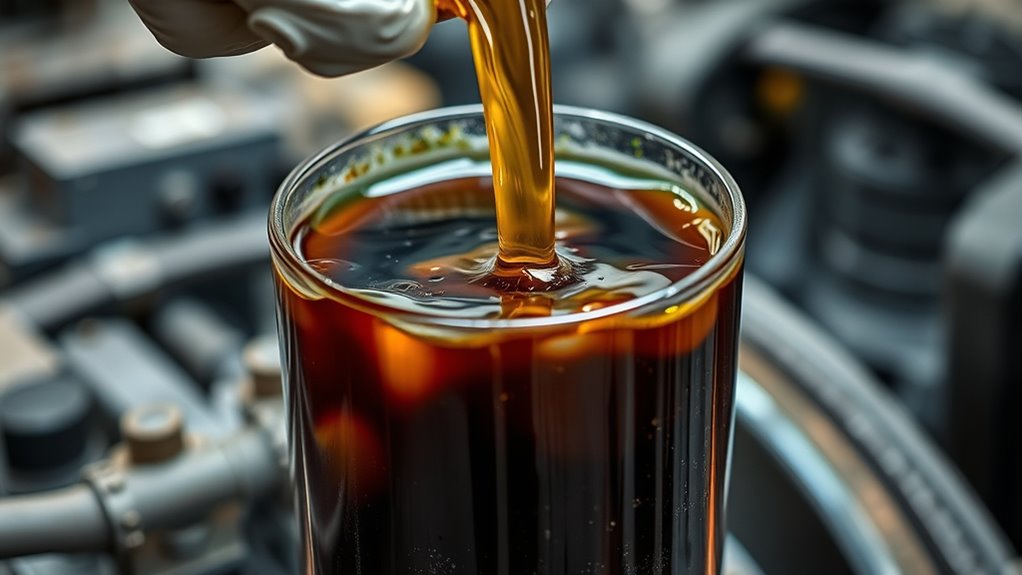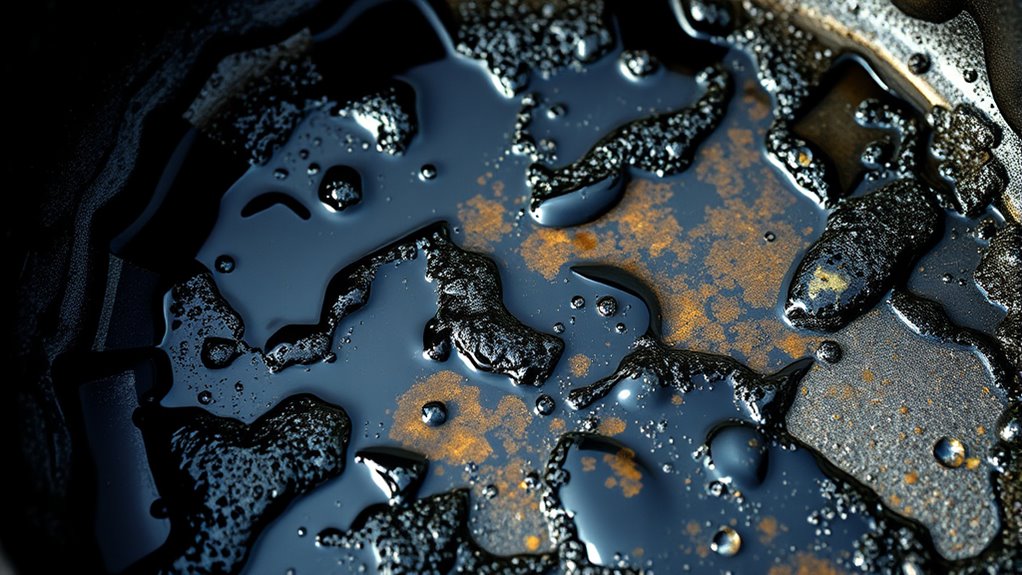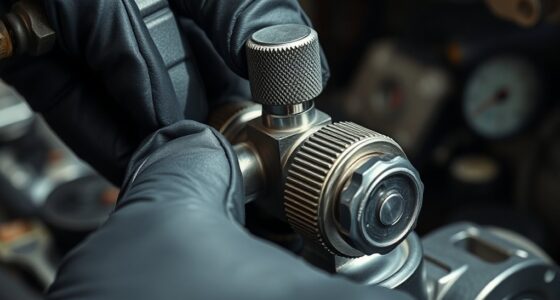To clean out water-contaminated hydraulic oil, start by draining all contaminated oil from the system thoroughly. Flush the system with clean, dry oil or a suitable flushing agent to remove water and sludge. Replace filters and any damaged seals, then refill with high-quality, water-free hydraulic oil. Conduct system tests to check for leaks and residual contamination. Continuing with proper maintenance techniques will help you keep your hydraulic system running smoothly and prevent future issues.
Key Takeaways
- Drain all contaminated oil completely, removing water, sludge, and debris from the system.
- Flush the hydraulic system with clean, dry oil or specialized flushing agents to eliminate residual water.
- Replace filters and inspect seals or damaged components for water ingress or corrosion.
- Refill with high-quality, water-free hydraulic oil to prevent future contamination.
- Conduct system testing to ensure no residual water remains and verify leak-free operation.

Hydraulic oil contamination is a common issue that can substantially impair the performance and longevity of your hydraulic systems. Water contamination, in particular, poses a serious threat because it can cause corrosion, reduce lubrication, and accelerate wear of internal components. When water gets into your hydraulic oil, it creates a hostile environment that can lead to system failure if not addressed promptly. The key to maintaining ideal system operation is effective water‑contaminated hydraulic oil clean‑out, which involves thorough removal of water and debris.
Water contamination in hydraulic oil can cause corrosion, wear, and system failure if not promptly addressed.
To begin, you need to understand the importance of filtration techniques in both preventing and removing water from your hydraulic oil. Proper filtration is your first line of defense against water contamination. Using high-quality filters designed specifically for water separation helps trap moisture before it reaches sensitive components. Regularly monitoring filter condition and replacing filters at recommended intervals ensures continued protection. Incorporating online water sensors can also alert you when water levels exceed safe limits, enabling swift action before damage occurs. Additionally, understanding the role of filter technology can significantly improve your water removal efficiency.
Contamination prevention is equally critical. Preventative measures include sealing systems properly to avoid moisture ingress, storing hydraulic oil in sealed containers, and controlling environmental humidity in your workspace. Implementing strict maintenance schedules minimizes the chances of water entering the system via leaks or maintenance errors. Additionally, using water‑resistant hydraulic oils can provide an extra layer of protection, especially in humid or water-prone environments.
When water contamination is detected, a thorough clean‑out process becomes necessary. First, you should drain the contaminated oil completely, ensuring all water and sludge are removed. This is often followed by flushing the system with clean, dry oil or a suitable flushing agent designed to dislodge residual water and contaminants. After flushing, you’ll need to replace filters and, if needed, replace seals and other components that may have been compromised by water exposure. Once cleaned, refill the system with high-quality, water-free hydraulic oil, and perform system tests to check for leaks or residual contamination.
Maintaining a strict schedule for oil analysis helps catch water contamination early, preventing costly damage. Regular sampling and testing allow you to detect trace amounts of water or other contaminants before they cause significant harm. In brief, effective filtration techniques combined with proactive contamination prevention strategies are essential for managing water‑contaminated hydraulic oil. Keeping your hydraulic systems dry and clean not only extends their lifespan but also ensures they operate efficiently, saving you time and money in the long run.
Frequently Asked Questions
How Often Should Hydraulic Oil Be Tested for Water Contamination?
You should test hydraulic oil for water contamination regularly, ideally every 3 to 6 months, depending on your operating conditions. Conduct oil sampling frequently to monitor contamination levels and catch issues early. Consistent contamination monitoring helps you identify water ingress promptly, preventing equipment damage. By staying proactive with testing intervals, you guarantee your hydraulic system remains clean and functions efficiently, reducing downtime and costly repairs.
What Are the Signs of Water Contamination in Hydraulic Systems?
You’ll notice water contamination in your hydraulic system through signs like inconsistent operation, increased wear, and frequent filter clogging. Water intrusion often causes visible moisture, which you can detect with moisture detection tools. Be alert for erratic movements or strange noises, as these indicate water presence. Regularly monitor for moisture buildup, and act quickly to prevent system damage and maintain ideal performance.
Can Contaminated Hydraulic Oil Be Reused After Cleaning?
You can reuse hydraulic oil after cleaning if you perform thorough oil filtration and contamination removal. First, check the oil’s condition with proper testing; if it meets acceptable standards, you can proceed. Use filtration systems designed for removing water and debris, ensuring no residual contaminants remain. Keep in mind, however, that reusing oil may reduce system longevity, so monitor performance closely and consider oil replacement if contamination levels are high.
What Are the Best Methods to Prevent Water Ingress Into Hydraulic Oil?
To prevent water ingress into hydraulic oil, you should regularly check and maintain seal integrity, ensuring seals are intact and functioning properly. Implement proper drainage procedures to avoid water accumulation, and keep the system sealed during operations and storage. Additionally, schedule routine inspections to detect potential leaks early, and use moisture barriers or desiccants if necessary. These steps help keep your hydraulic system free of water contamination, improving performance and longevity.
How Does Water Contamination Affect Hydraulic System Performance?
Water contamination reduces hydraulic system performance by accelerating oil degradation and increasing corrosion risks. You’ll notice reduced efficiency, sluggish operation, and potential component damage. Water promotes the breakdown of hydraulic oil, impairing lubrication and sealing properties. Corrosion risks rise as moisture causes metal parts to rust, leading to costly repairs. To maintain ideal performance, regularly check for water presence, use proper filtration, and promptly address any contamination issues.
Conclusion
Cleaning water-contaminated hydraulic oil might seem like a tedious task, but neglecting it can cause costly damage. Think of your equipment as a finely tuned machine; just as water can rust a metal blade, contamination can wear down your system’s essential parts. By acting swiftly to clean out the water, you protect your investment and ensure smooth operation. Sometimes, the simplest steps—like removing water—can prevent the biggest failures.








